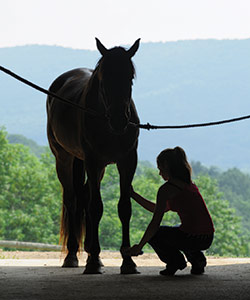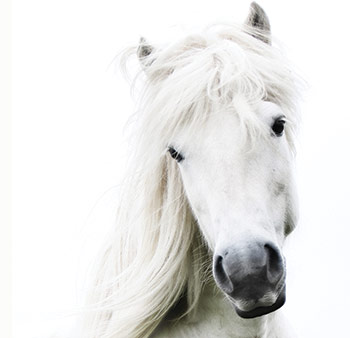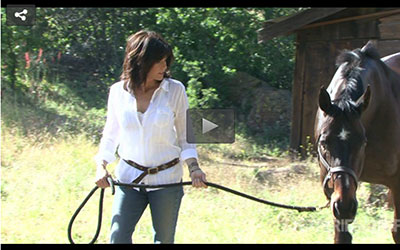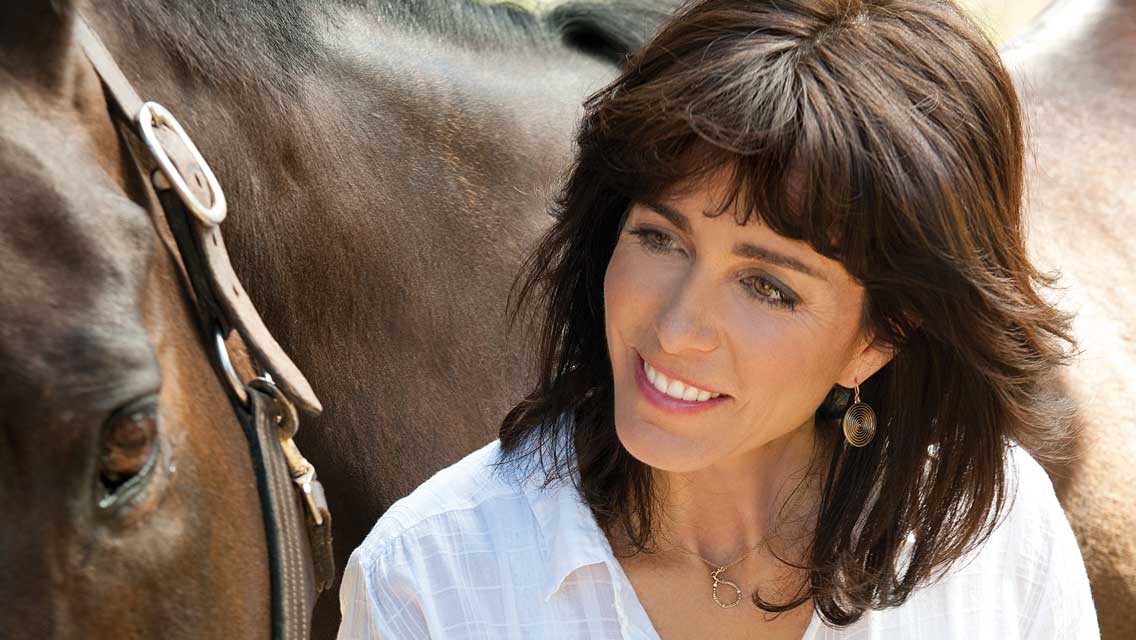You don’t know quiet until you’re eye to eye with a mustang.
The air in the corral was heavy and sweet with the smell of hay and horse. I stood, motionless, suspended in the gaze of the animal’s large, luminous, dark eyes. He took a deep breath, expanding his nostrils, then took a step closer to me. I reached out and touched him tentatively, then ran my hand down his long, warm face. All of my senses were on high alert — and yet I felt calmer than I’d been in weeks.
There are six people watching me from the sidelines, taking notes; one of them is my mother, whom I brought to Moon Shadow Ranch in Berthoud, Colo., to participate in the Coaching With Horses program as a Mother’s Day gift. She’s a 66-year-old travel consultant whose globetrotting ways have been curtailed by chronic peripheral neuropathy in her feet. I hoped a visit with some horses, which she has always loved, would prove to be healing.
Until this moment, though, I didn’t have a sense of just how much the great beasts had to teach both of us.
The New Role of Horses
Horses have long held a special place in cultural imagination, inspiring countless novels, songs, and movies. In his book Dreaming the Soul Back Home, dream expert Robert Moss describes this mythic creature as a “healer and teacher, as a vehicle for travel to higher realms, and as the source of creative inspiration.” For more than 10,000 years, humans and horses have lived and worked together — and for 30,000 years before that, our ancestors watched them intently, painting their images on cave walls. And while your average urban American may rarely cross paths with an Arabian or palomino, horses are not simply the domain of cattle ranchers and mounted police. Annually, the $39 billion industry, which includes using horses for ranching, racing, and pleasure riding, employs 700,000 people in the United States.
Increasingly, say experts in the fast-growing world of hippotherapy (the formal name for equine-facilitated therapy) we’re also using horses to become healthier psychologically. There are now some 250 centers across North America that offer certified hippotherapy. “They may not be carrying us to war or plowing our fields, but they’re doing something more important,” says Linda Kohanov, author of The Power of the Herd. “When we can let go of the horse as a vehicle for competition or ego, we can be open to what the horse is teaching us about being balanced and empowered in human society. They’re not working for us, but on us.”
The origins of hippotherapy (hippos is Greek for “horse”) extend as far back as ancient times. Modern-day equine therapy began in the 1960s, when therapeutic riding centers in Europe and the United States began using horses as adjuncts to physical therapy.
Physical therapists understood that riding horses increases core strength, balance, posture, and motor and sensory skills, which can be significant in helping children and adults with disabilities and those recovering from physical trauma. They also came to realize that there was more to this therapy than just the functional element. “People started to notice that those engaged in riding, be it for disabilities, spinal-cord injuries, or other problems, also became more emotionally centered and healed,” says Kohanov. “That’s when the field of equine-facilitated mental health began to emerge.”
The Power of Prey

The moment my mother and I stepped onto the gorgeous, sprawling Moon Shadow Ranch just north of Denver, we knew we were in horse country. This is where Kathy Pike, a life coach and author of Hope . . . From the Heart of Horses, teaches team building, spiritual awareness, and leadership skills. One big piece of Pike’s mission is showing participants, who range from entrepreneurs to high-level executives, how to use their time with horses to improve their relationship skills.
“As humans, we’re so cluttered with regrets, doubts, and anxieties, and so rarely in the moment, that we’re unable to be clear,” Pike says. This compromises relationships and leadership ability. Through interactions with the horse, she explains, we become aware of the obstacles and fears that hold us back. Or, as Kohanov states: “Once you learn to hold your ground with a 1,000-pound animal, you can set your boundaries with people
pretty easily.”
So why horses? Why not a dog or a cat — or a goat, for that matter? A dog is a predator, and so is your cat. Goats don’t exactly inspire power, and they’re ornery. Horses, on the other hand, are prey animals and equipped with keen intuitive and sensory capabilities that evolved to keep them alive. Because their survival depends on their ability to sense what’s going on around them at all times, they live in a state of heightened but relaxed awareness.
We humans are predators with a strong cultural preference for logical, rational thinking; we like to hole up in our heads, particularly the left hemisphere of our brains, which governs language, logic, and reason. “Most of us spend our whole lives there,” says Allan Hamilton, MD, brain surgeon, horse trainer, and author of Zen Mind, Zen Horse.
And this is why horses are a salvation for so many people. “It doesn’t matter what you say, what lies you tell yourself or the horse,” Hamilton says. “All that matters is what you feel.”
Because horses traffic in energy, not language, they help quiet the logical left brain and awaken the sensing right side. Hamilton calls horses “divine mirrors.” They reflect what we put out into the world — a valuable lesson for most of us who have no idea how much our energy affects others. “The horse translates into physical terms what you can see and feel, bringing awareness to what we’re doing, how we’re living.”
I experienced this myself years earlier at the Equine Experience created by Wyatt Webb at Miraval Resort & Spa near Tucson, Ariz.
When Webb instructed me to clean my horse’s hooves, I was gripped with terror. I began to cry as I tugged at the immense draft horse’s leg. He wouldn’t budge. Webb took me aside and asked what was going on. “That horse isn’t going to take me seriously,” I muttered through tears. “Why would he? Why would anyone?” Hmm, interesting.
After I’d calmed down, Webb directed me to try again. This time, I approached the horse feeling grounded and focused — and he allowed me to pick up his foot right away.
Reining It In

What arises in our interactions with horses reveals quite a bit about us. But if you ask Webb, it’s not about the horse at all. (His book is actually called It’s Not About the Horse.) He believes the work is about understanding and overcoming two of the biggest forces at play in our lives: fear and self-doubt.
Equine-assisted therapy allows you to be near a powerful animal and sense what real presence is. You may find it spiritual or incredibly calming. But whether you believe a horse is a mystical being or a functional facilitator, it doesn’t matter. The idea is to let yourself feel what it means to just be.
That weekend at Moon Shadow Ranch with my mom, I became aware of how often my left brain intrudes on meaningful experiences. For 20 minutes in the corral, a sweet-eyed mustang named Corazón and I did a subtle, quiet dance — sometimes I moved in, other times I gave him space, and sometimes we just stood, silently regarding each other. I surrendered to the moment, with no goal or objective. When I emerged from my session, my mother said she had never seen me stand still or be that quiet for that long — maybe ever.
“I wish you could have that peace, every day,” she said. My workshop companions all nodded.
And for a moment, I felt like I had found my place in the herd.
Saddle Up
The following sites offer hippotherapy programs to assist people with personal growth through equine-facilitated therapy:
Coaching With Horses at Moon Shadow Ranch — Berthoud, Colo.
This equine-facilitated learning and coaching program aims to help participants build greater confidence and “heart-based” leadership skills
Equine Experience at Miraval — Tucson, Ariz.
The program at Miraval Resort & Spa places special focus on providing “profound insight into communication within relationships.”
Vista Caballo — Dove Creek, Colo.
At a visit to this ranch in the Great Sage Plains, individuals and teams work with horses with the goal of overcoming obstacles to their personal evolution and growth.
Equinection — Green Mountain, N.C.
This retreat in the mountains of North Carolina uses equine-facilitated learning to aid addiction recovery, among other things.
Emotional Agility Exercise: Handle Yourself Like a Horse
More often than not, we’re taught to keep a lid on our emotions, which can cause us to disconnect from them. As prey animals and sentient beings, horses use emotions as information — their survival depends on it. “The second I started to use emotions this way, my life became saner and more enjoyable,” says horse expert Linda Kohanov, author of The Power of the Herd. She developed the following Four-Point Method for Emotional Agility to help thousands of people align thought, feeling, and action for optimal performance and better relationships.
1. Feel the emotion in its purest form. Most of us never get past this step. We refrain from feeling emotions because we think they’ll cause us more trouble.
2. Get the message behind the emotion. If that feeling could talk to you, what would it say? What is driving it and what is it telling you?
3. Change something in response to the message. What can you do to address this message? If you’re feeling threatened, is there some action you can take to protect yourself? If you’re frustrated, what other approach can you take?
4. Go back to grazing. Now you can let the emotion go, and either get back on task, or relax, enjoying life fully. Hanging onto the emotion itself is as bad as blocking it, and endlessly ruminating doesn’t help, nor is it necessary, if you’ve taken action.




This Post Has 0 Comments